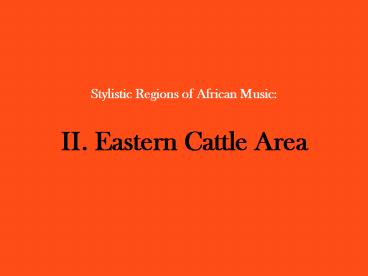Stylistic Regions of African Music: - PowerPoint PPT Presentation
1 / 7
Title:
Stylistic Regions of African Music:
Description:
Each dancer in Bwola dances of the Acholi carries a small drum in the left hand and a beating stick in the right hand (each dancer playing the same unison rhythms) ... – PowerPoint PPT presentation
Number of Views:104
Avg rating:3.0/5.0
Title: Stylistic Regions of African Music:
1
Stylistic Regions of African Music
- II. Eastern Cattle Area
2
Stylistic Regions
3
Eastern Cattle Area
Documentary history for much of this region
begins in the early second century with The
Circumnavigation of the Indian Ocean, a
commercial handbook written in Greek. Early
sailors along the shores of what is now Somalia,
Kenya, and Tanzania describe the markets as part
of the efficient network of Indian Ocean trade.
1 Uganda, Kenya, and Tanzania form the
618,934-square-mile area of East Africa. The
music, customs, creeds, languages, and general
ways of living are so diverse that it is
difficult to draw general conclusions regarding
style. It is clear, though, that the music is
extremely rich in rhythm. Rhythms serve a vital
function in all dancing and as a means of
communication in daily life. 1 Roland Oliver,
The Dawn of African History (New YorkNew York
Oxford University Press, 1968), p. 45. ? ? ?
4
Tribes of East Africa (e.g., Sogo, Ganda, and
Acholi) prefer quick and hot rhythms in
dancing. Slow and graceful rhythms are popular
among the Tusi (Watusi), Kiga, and Karamojang
dancers. These rhythms are rich enough to sustain
dancing without instrumental or vocal
accompaniment. The chief dancing instrument is
the drum. In addition to tuned drums of the Ganda
people, large drum ensembles are common but never
comprise more than four to six drums. The
drumming among the Ganda in Nankasa involves the
use of such drums of varying sizes. Expanded
ensembles would merely double these standard
instruments. Each dancer in Bwola dances of the
Acholi carries a small drum in the left hand and
a beating stick in the right hand (each dancer
playing the same unison rhythms). In nearly all
areas of East Africa clapping is very common,
though it is not always used to accompany dances.
In the bwola, dingi-dingi, and laraka oraka
dances of the Achoi, clapping is not used at all.
Possibly because of the highly organized nature
of Agwara dances (which leaves little room for
improvisation), clapping is likewise omitted from
the bwola and dingi-dingi dance styles. In
various other dances, however, clapping helps
singers and drummers to keep steady time. This
also enables musicologists to determine accents
when transcribing traditional African rhythms. ?
? ?
5
In Bugunda, a region in western Uganda, drums are
sounded to call people to do communal work, such
as the building of village roads or footbridges
across swamps (bulungi bwansi). Drums warn people
of approaching danger and call them to defend
their village. The use of drums for calling
people to worship came with the introduction of
Christianity. Shouting while beating the lips
rhythmically is also used to signal villagers of
approaching individuals. ? ? ? Ugandan
musician Samite Mulondo Image courtesy of Samite
Mulondo --- www.samite.com
6
Uganda Musical Instruments
- A selection of musical instruments commonly found
in Ugandan traditional music - Sansa (Thumb Piano)
- Endongo/Entongoli (Lyres)
- Amadinda/Akadinda (Xylophones)
- Enanga/Adundu (Arched Harp)
- Indingidi (One-stringed fiddle)
- Engalabi (Drum)
- Ensasi (Shakers)
- Emkwanzi/Oburere (Panpipes)
Endongo/Entongoli
7
Ethiopia Musical Instruments
- A selection of musical instruments commonly found
in Ethiopian traditional music - Krar/Dita/Beganna, a.o. (lyres)
- Masengo (bowed lute)
- Washint/Embilta (flutes)
- Fanta (panpipes)
- Sanasel/Tsinatsil (sistrum)
- Holdudwa (animal horn)
- Kabaro/Nagarit (kettle drums)
Sistrum --- used in the music of the Ethiopian
Orthodox Church. The sistrum has its roots in
ancient Egypt.
A particularly beautiful example of this ancient
instrument can be found at the website of the
Metropolitan Museum of Art ---
http//www.metmuseum.org/toah/hd/oking/ho_26.7.145
0.htm ? ? ?































